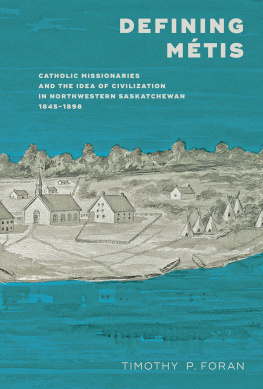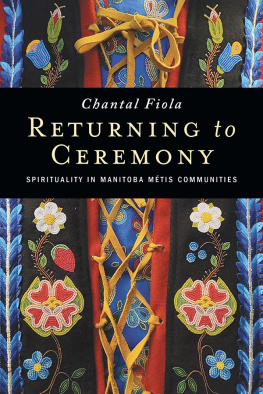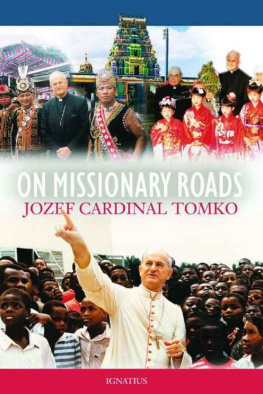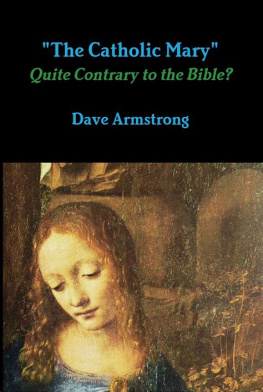Timothy P. Foran 2017
20 19 18 17 1 2 3 4
All rights reserved. No part of this publication may be reproduced or transmitted in any form or by any means, or stored in a database and retrieval system in Canada, without the prior written permission of the publisher, or, in the case of photocopying or any other reprographic copying, a licence from Access Copyright, www.accesscopyright.ca, 1-800-893-5777.
University of Manitoba Press
Winnipeg, Manitoba, Canada
Treaty 1 Territory
uofmpress.ca
Cataloguing data available from Library and Archives Canada
ISBN 978-0-88755-774-3 (PAPER)
ISBN 978-0-88755-513-8 (PDF)
ISBN 978-0-88755-511-4 (EPUB)
Cover design by Marvin Harder
Interior design by Karen Armstrong
Maps by Weldon Hiebert. Maps contain information licensed under the Open Government LicenceCanada.
On the cover is a view of of the Saint-Jean-Baptiste mission at le--la-Crosse drawn by Henri Julien (1903), based on an 1874 sketch by Sara Riel. Centre du patrimoine, La Socit historique de Saint-Boniface, SHSB 14879.
Printed in Canada
The University of Manitoba Press acknowledges the financial support for its publication program provided by the Government of Canada through the Canada Book Fund, the Canada Council for the Arts, the Manitoba Department of Sport, Culture, and Heritage, the Manitoba Arts Council, and the Manitoba Book Publishing Tax Credit.

CONTENTS
LIST OF ILLUSTRATIONS
. The Diocese of Saint-Boniface, 1854. Source: Champagne, Les dbuts de la mission dans le Nord-Ouest canadien, 52.
. The Diocese of Saint-Albert and neighbouring jurisdictions, 1871. Source: Champagne, Les dbuts de la mission dans le Nord-Ouest canadien, 57.
PREFACE
This book is about Roman Catholic missionaries and the ways that they thought and wrote about Indigenous people in the latter half of the nineteenth century. Its focus is very different from the one I had intended when I began my research in 2006. In the early spring of that year, I learned that the Socit historique de Saint-Boniface (Winnipeg) had recently acquired and accessioned a collection of French-language Catholic mission records from the Mtis community of le--la-Crosse in northwestern Saskatchewan. The collection spanned nearly a century and a half, from the establishment of a Catholic missionary presence at le--la-Crosse in 1845 to the completion of the last mission journal in 1988. It contained a wealth of information on the local community: a running chronicle of daily life, genealogies of congregant families, sacramental records, and more. Never before had the collection been available to lay researchers, so if I hurried, I would be the first to use it as a corpus of primary sources. Here, I thought, was a golden opportunity to produce a sweeping ethnohistorical study of a Mtis community using methods that were tried, tested, and true: scholars have long reliedand continue relyingon mission records to yield qualitative and quantitative information on the historical Mtis.
My initial enthusiasm turned to confusion, however, when I examined the collection and found very few references to a local Mtis populationthe putative subject of my studyuntil the mid-1870s. Up to then, missionary record-keepers seemed to have referred to all local Indigenous people as des sauvages, subcategorizing them according to linguistic criteria as des Cris Yet these records contained few explicit references to des mtis until more than a full generation after the missionaries arrival.
As I attempted to account for this apparent incongruity, my attention turned toward missionary record-keepers themselves and away from the people whom they purported to describe. I became increasingly interested in the missionaries use of the categories sauvage and mtis and in the forces that shaped their understanding and application of these categories. Pursuing this line of research meant delving deeper into the archival record and consulting letters, journals, and reports written by the missionaries of le--la-Crosse and by their confrres/consurs, superiors, and lay associates across North America and Europe. A careful reading of these sources convinced me that missionary-made categories of indigeneity reveal far more about missionary assumptions, motives, and world views than they do about actual Indigenous collectivities. Indeed, the categories sauvage and mtis appear to have shifted and evolved in response to broad changes affecting the Catholic apostolate on the local, regional, and global levels.
Although constructed by missionaries and imbued with missionary meaning, these categories acquired influence well beyond missionary circles. The Canadian state appropriated them to classify and govern Indigenous people: in northwestern Saskatchewan, for instance, missionary-made categories played a critical role in drawing legal and administrative distinctions between Indians and Half-breeds after the onset of federal intervention in local affairs in 1898the end year of this study. Additionally, these categories suffuse works of history, anthropology, and other social sciences whose authors have drawn on mission recordswith varying degrees of critical awarenessto elucidate aspects of Indigenous peoples past and present. This practice is sure to continue, even to intensify, on the heels of the 2015 research recommendations of the Truth and Reconciliation Commission of Canada and recent case law inviting re-examination of Mtis identity and citizenship. I hope, therefore, that this book will enhance researchers understanding of missionary-made categories by situating them within the context in which they were originally constructed, applied, and understood.
INTRODUCTION
From sauvage to mtis: The Evolution of Missionary-Made Categories at le--la-Crosse
On 24 May 1845, abb Jean-Baptiste Thibault wrote an uncharacteristically forceful letter to his bishop. The normally stolid missionary reported that he had just visited the Hudsons Bay Company (HBC) post at le--la-Crosse, where he had encountered eighty Montagnais families who earnestly desired religious instruction. Unfamiliar with their language, Thibault had endeavoured to teach them the Paternoster, the Ave Maria, the Credo, and the Gloria Patris in French. Then, before resuming his itinerant mission, he had promised these bons sauvages that he would send them priests who would learn their language and provide them with regular spiritual care. Thibault insisted on the urgency of the situation: le--la-Crosse was ripe for mass conversion, and the Catholic Church needed to seize the opportunity before its Protestant rivals did. He therefore urged his bishop to waste no time in dispatching missionaries to le--la-Crosse and assured him that these missionaries would be welcomed enthusiastically by the locals. Never, asserted Thibault, was a sauvage people better disposed to embrace the faith than are the Montagnais.
Fifty-four years later, the resident priest at le--la-Crosse bemoaned the faithlessness and degeneracy of the local population. A year after assuming direction of Saint-Jean-Baptiste mission, Father Jean-Marie Pnard undertook a little inquisition among his regular congregantsto whom he referred collectively as our mtisin early January 1899.













